News
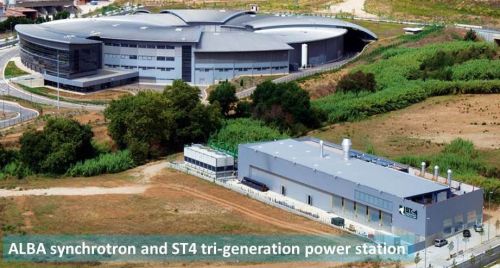
23/06/2016
Distributed Polygeneration: Barcelona Synchrotron Park Shares Its Experience
Distributed Polygeneration: Barcelona Synchrotron Park Shares Its Experience
In order to reduce the environmental impact of its urban development, Barcelona Synchrotron Park has designed and built a centralized heating and cooling system based on high efficiency polygeneration technologies that allow the simultaneous production of electricity, heating and cooling distributed throughout the park. This approach helps reduce primary consumption and CO2 emission by 35% compared to conventional air-conditioning systems installed in each company.
The first planned polygeneration power plant has being operative since 2010. Public-private “Poligeneració Parc de l’Alba ST4 S.A.” company designed and built the plant and currently operates it. The plant produces the high quality electricity ALBA synchrotron requires and provides all companies from the park with heating and cooling.
Due to its experience acquired in this field, Barcelona Synchrotron Park has been invited to a workshop organized on June 22 by Granollers city council (Barcelona area), Granollers Mercat and Vallès Oriental waste-management consortium on the theme “Heating distribution in industrial areas based on residual heating and other renewable energy sources”.
This workshop offered an opportunity to share know-how and experiences and to answer key questions about legal, technical and economic issues that city councils have to face to set up this type of infrastructures. End-users and industrial consumers issues were also tackled during the meeting.
The first planned polygeneration power plant has being operative since 2010. Public-private “Poligeneració Parc de l’Alba ST4 S.A.” company designed and built the plant and currently operates it. The plant produces the high quality electricity ALBA synchrotron requires and provides all companies from the park with heating and cooling.
Due to its experience acquired in this field, Barcelona Synchrotron Park has been invited to a workshop organized on June 22 by Granollers city council (Barcelona area), Granollers Mercat and Vallès Oriental waste-management consortium on the theme “Heating distribution in industrial areas based on residual heating and other renewable energy sources”.
This workshop offered an opportunity to share know-how and experiences and to answer key questions about legal, technical and economic issues that city councils have to face to set up this type of infrastructures. End-users and industrial consumers issues were also tackled during the meeting.

17/06/2016
Barcelona Synchrotron Park Sponsors the Fifth Ideas Generation Program
Barcelona Synchrotron Park Sponsors the Fifth Ideas Generation Program
The main mission of the Universitat Autònoma de Barcelona Research Park (PRUAB), which is associated with Barcelona Synchrotron Park, is technology transfer: how to transform the results achieved in UAB research centers into economic growth (jobs, patents, start-up companies…).
In this sense, an original tool developed by PRUAB in the last 4 years is the annual Ideas Generation Program based on: 1) Collecting technology challenges posed by local companies from a given sector, 2) Inspiring solutions from the UAB scientific community, 3) Training researchers to help them make their proposal a reality (assessment to elaborate a business plan, create a start-up etc.), 4) Evaluating these projects by experts, 5) Rewarding the best projects.
In the last four editions focused on ICT technologies, biotechnologies, environment and aerospace sectors, respectively, 52 projects have been generated and 8 of them have been transformed into currently operative companies that could get a global amount of 900,000 euros founds.
Barcelona Synchrotron Park supports this initiative that helps the economic development of the local territory and sponsors the fifth program, which this year is devoted to cultural industries. This new edition starts now and will conclude on December 1 with the awards ceremony.
In this sense, an original tool developed by PRUAB in the last 4 years is the annual Ideas Generation Program based on: 1) Collecting technology challenges posed by local companies from a given sector, 2) Inspiring solutions from the UAB scientific community, 3) Training researchers to help them make their proposal a reality (assessment to elaborate a business plan, create a start-up etc.), 4) Evaluating these projects by experts, 5) Rewarding the best projects.
In the last four editions focused on ICT technologies, biotechnologies, environment and aerospace sectors, respectively, 52 projects have been generated and 8 of them have been transformed into currently operative companies that could get a global amount of 900,000 euros founds.
Barcelona Synchrotron Park supports this initiative that helps the economic development of the local territory and sponsors the fifth program, which this year is devoted to cultural industries. This new edition starts now and will conclude on December 1 with the awards ceremony.
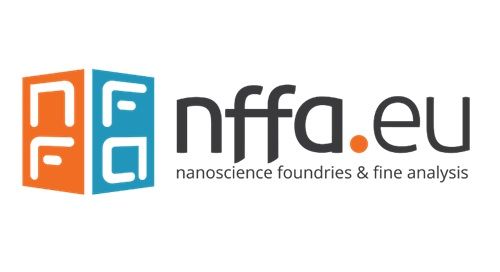
10/06/2016
The Nanoworld Is Designed and Observed In and Nearby Barcelona Synchrotron Park
The Nanoworld Is Designed and Observed In and Nearby Barcelona Synchrotron Park
Last week, the new NFFA Europe program, which kicked off this year, was presented at the Universitat Autònoma de Barcelona – UAB University.
NFFA stands for Nanoscience Foundries and Fine Analysis. It is a new scientific infrastructure distributed across Europe that offers researchers and companies a free access to a wide range of tools to perform growth, nano-lithography, nano-characterization, theory and simulation and fine-analysis with synchrotron, FEL and neutron radiation sources.
This network gathers 15 centers from 8 different countries and the UAB campus, the Barcelona Synchrotron Park strategic partner, is one of them. More specifically, the Institute of Material Science of Barcelona (ICMAB), the Catalan Institute of Nanoscience and Nanotechnology (ICN2), the Institute of Microelectronics of Barcelona and ALBA synchrotron are involved in the NFFA initiative. The program is coordinated in Barcelona by the UAB research park (PRUAB) and ICN2.
Until at least 2020, each researcher or company that needs these tools to develop and characterize nanomaterials can apply for one or more of these centers (one mandatory condition is to apply for facilities located in a foreign country) through a permanent call with every 3 months deadline. An international committee of experts advices candidates and selects the best proposals. Selected projects get a free access to the requested facilities and can even get a travel and subsistence support.
In order to promote this new infrastructure, a first NFFA summer school is organized in next July on the UAB campus.
Welcome to the UAB campus!
All the information is available on the NFFA website.
NFFA stands for Nanoscience Foundries and Fine Analysis. It is a new scientific infrastructure distributed across Europe that offers researchers and companies a free access to a wide range of tools to perform growth, nano-lithography, nano-characterization, theory and simulation and fine-analysis with synchrotron, FEL and neutron radiation sources.
This network gathers 15 centers from 8 different countries and the UAB campus, the Barcelona Synchrotron Park strategic partner, is one of them. More specifically, the Institute of Material Science of Barcelona (ICMAB), the Catalan Institute of Nanoscience and Nanotechnology (ICN2), the Institute of Microelectronics of Barcelona and ALBA synchrotron are involved in the NFFA initiative. The program is coordinated in Barcelona by the UAB research park (PRUAB) and ICN2.
Until at least 2020, each researcher or company that needs these tools to develop and characterize nanomaterials can apply for one or more of these centers (one mandatory condition is to apply for facilities located in a foreign country) through a permanent call with every 3 months deadline. An international committee of experts advices candidates and selects the best proposals. Selected projects get a free access to the requested facilities and can even get a travel and subsistence support.
In order to promote this new infrastructure, a first NFFA summer school is organized in next July on the UAB campus.
Welcome to the UAB campus!
All the information is available on the NFFA website.
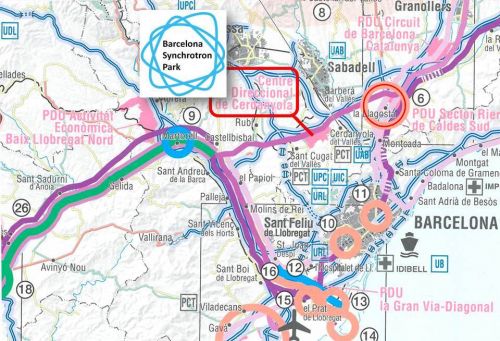
02/06/2016
Mediterranean Corridor: an important infrastructure for Barcelona Synchrotron Park
Mediterranean Corridor: an important infrastructure for Barcelona Synchrotron Park
In the European Union, railway represents 18.4% of the freight transport, 3 times more than in Spain (5.2%).
Carrying out the Mediterranean corridor would be decisive in order to increase the Spanish percentage in favor of this sustainable way of transporting goods (less pollution, less CO2, less accident than for trucks).
This international European gauge railway corridor aims to connect the port of Cadiz (south of Spain) with the port of Barcelona (north), via the ports of Malaga, Almeria, Valencia, Tarragona etc., before continuing to France and the rest of Europe. This railway, which would link all the Mediterranean Spanish border regions, would connect 48% of the Spanish population, 44% of its GDP, 49% of its importations and 51% of its exportations.
This railway corridor is one of the key elements of the Trans-European Transport Network (TEN-T) designed in Brussels. In order to accelerate its execution, the Catalan government has recently created a table, the so-called Mediterranean Corridor Strategic Table that includes a 5.6 billion Euros investment just in Catalonia.
Among the different documents (in Catalan) prepared for this table (all data included in this news were taken from them), a map details the Mediterranean corridor in Catalonia. As far as Barcelona is concerned, it can be seen (see image) that one of the corridor section leaves from the port, runs along the Barcelona Synchrotron Park (“Centre direccional de Cerdanyol” shown on the map corresponds to the local administrative name of the park) and connects to La Llagosta (20 minutes far from the park) where an intermodal station for trains and trucks will be constructed by 2020 as a priority infrastructure.
Very good news for Barcelona Synchrotron Park, its territory and its companies.
Carrying out the Mediterranean corridor would be decisive in order to increase the Spanish percentage in favor of this sustainable way of transporting goods (less pollution, less CO2, less accident than for trucks).
This international European gauge railway corridor aims to connect the port of Cadiz (south of Spain) with the port of Barcelona (north), via the ports of Malaga, Almeria, Valencia, Tarragona etc., before continuing to France and the rest of Europe. This railway, which would link all the Mediterranean Spanish border regions, would connect 48% of the Spanish population, 44% of its GDP, 49% of its importations and 51% of its exportations.
This railway corridor is one of the key elements of the Trans-European Transport Network (TEN-T) designed in Brussels. In order to accelerate its execution, the Catalan government has recently created a table, the so-called Mediterranean Corridor Strategic Table that includes a 5.6 billion Euros investment just in Catalonia.
Among the different documents (in Catalan) prepared for this table (all data included in this news were taken from them), a map details the Mediterranean corridor in Catalonia. As far as Barcelona is concerned, it can be seen (see image) that one of the corridor section leaves from the port, runs along the Barcelona Synchrotron Park (“Centre direccional de Cerdanyol” shown on the map corresponds to the local administrative name of the park) and connects to La Llagosta (20 minutes far from the park) where an intermodal station for trains and trucks will be constructed by 2020 as a priority infrastructure.
Very good news for Barcelona Synchrotron Park, its territory and its companies.
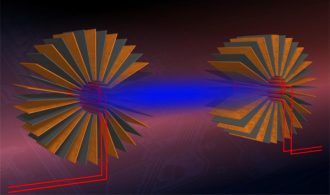
26/05/2016
UAB University Makes Distance Wireless Charging a Reality
UAB University Makes Distance Wireless Charging a Reality
Charging devices without the need of taking them out of one’s pocket is both a technologic and economic challenge.
A group of researchers from the Department of Physics of Universitat Autònoma de Barcelona, which is a Barcelona Synchrotron Park key partner, have developed a system which can efficiently transfer electrical energy between two separated circuits thanks to the use of metamaterials which combine layers of ferromagnetic materials, such as magnets, and conductor materials such as copper. The metamaterials envelop the emitter and receptor and enable transferring electrical energy between the two, at a distance and with unprecedented efficiency.
With the use of metamaterial crowns researchers were able in the lab to increase the transmission efficiency 35-fold, “and there is much more room for improvement, since theoretically the efficiency can be increased even more if conditions and the design of the experiment are perfected” explains Àlvar Sánchez, director of the research.
Published last week in Advanced Materials, the research was conducted by researchers from the Electromagnetism Group of the UAB Department of Physics Àlvar Sánchez (also an ICREA Acadèmia researcher) and Carles Navau, with the collaboration of Jordi Prat, currently researcher at the Institute for Quantum Optics and Quantum Information of the Austrian Academy of Sciences in Innsbruck.
The device has been patented by the UAB and several companies abroad have already showed interest in applying the technology to their products.
News based on the press release published by UAB.
Image: Jordi Prat, UAB
A group of researchers from the Department of Physics of Universitat Autònoma de Barcelona, which is a Barcelona Synchrotron Park key partner, have developed a system which can efficiently transfer electrical energy between two separated circuits thanks to the use of metamaterials which combine layers of ferromagnetic materials, such as magnets, and conductor materials such as copper. The metamaterials envelop the emitter and receptor and enable transferring electrical energy between the two, at a distance and with unprecedented efficiency.
With the use of metamaterial crowns researchers were able in the lab to increase the transmission efficiency 35-fold, “and there is much more room for improvement, since theoretically the efficiency can be increased even more if conditions and the design of the experiment are perfected” explains Àlvar Sánchez, director of the research.
Published last week in Advanced Materials, the research was conducted by researchers from the Electromagnetism Group of the UAB Department of Physics Àlvar Sánchez (also an ICREA Acadèmia researcher) and Carles Navau, with the collaboration of Jordi Prat, currently researcher at the Institute for Quantum Optics and Quantum Information of the Austrian Academy of Sciences in Innsbruck.
The device has been patented by the UAB and several companies abroad have already showed interest in applying the technology to their products.
News based on the press release published by UAB.
Image: Jordi Prat, UAB
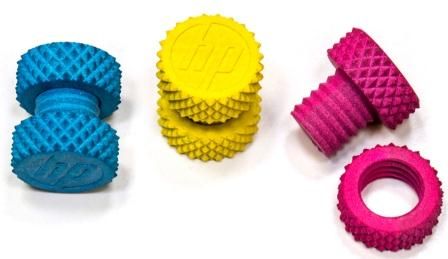
19/05/2016
HP Enters the 3D Printing Market
HP Enters the 3D Printing Market
At the 2016 Rapid conference held this week in Orlando, Florida, HP presented its new 3D printing system based on an in-house technology developed in Sant Cugat, just two steps away from Barcelona Synchrotron Park, where the large format printing world division of the American multinational is headquartered.
According to HP, the so-called Multi Jet Fusion technology is up to 10 times faster and 2 times cheaper to run than rival systems for small and medium mass production. This technology will be used as an open platform with certified users as printing material or software companies. New printers will be released in two versions at the end of the year (for prototypes and for small-scale production runs).
3D printing has a considerable potential and HP thinks that in few years this business will be more important for the company than the large format one. In this perspective, HP recruited 200 new engineers last year in Sant Cugat and plans to hire 250 more this year.
According to HP, the so-called Multi Jet Fusion technology is up to 10 times faster and 2 times cheaper to run than rival systems for small and medium mass production. This technology will be used as an open platform with certified users as printing material or software companies. New printers will be released in two versions at the end of the year (for prototypes and for small-scale production runs).
3D printing has a considerable potential and HP thinks that in few years this business will be more important for the company than the large format one. In this perspective, HP recruited 200 new engineers last year in Sant Cugat and plans to hire 250 more this year.









